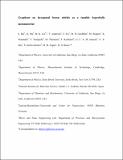Graphene on hexagonal boron nitride as a tunable hyperbolic metamaterial
Author(s)
Dai, S.; Liu, M. K.; Fei, Z.; Goldflam, M. D.; Wagner, M.; Watanabe, K.; Taniguchi, T.; Thiemens, M.; Keilmann, F.; Janssen, G. C. A. M.; Zhu, S-E.; Jarillo-Herrero, P.; Fogler, M. M.; Basov, D. N.; Ma, Qiong; Andersen, Trond Ikdahl; ... Show more Show less
DownloadGraphene on hexagonal.pdf (1.577Mb)
OPEN_ACCESS_POLICY
Open Access Policy
Creative Commons Attribution-Noncommercial-Share Alike
Terms of use
Metadata
Show full item recordAbstract
Hexagonal boron nitride (h-BN) is a natural hyperbolic material1, in which the dielectric constants are the same in the basal plane (ε[superscript t] ≡ ε[superscript x] = ε[superscript y]) but have opposite signs (ε[superscript t] ε[superscript z ]< 0) in the normal plane (ε[superscript z]). Owing to this property, finite-thickness slabs of h-BN act as multimode waveguides for the propagation of hyperbolic phonon polaritons—collective modes that originate from the coupling between photons and electric dipoles in phonons. However, control of these hyperbolic phonon polaritons modes has remained challenging, mostly because their electrodynamic properties are dictated by the crystal lattice of h-BN. Here we show, by direct nano-infrared imaging, that these hyperbolic polaritons can be effectively modulated in a van der Waals heterostructure composed of monolayer graphene on h-BN. Tunability originates from the hybridization of surface plasmon polaritons in graphene with hyperbolic phonon polaritons in h-BN so that the eigenmodes of the graphene/h-BN heterostructure are hyperbolic plasmon–phonon polaritons. The hyperbolic plasmon–phonon polaritons in graphene/h-BN suffer little from ohmic losses, making their propagation length 1.5–2.0 times greater than that of hyperbolic phonon polaritons in h-BN. The hyperbolic plasmon–phonon polaritons possess the combined virtues of surface plasmon polaritons in graphene and hyperbolic phonon polaritons in h-BN. Therefore, graphene/h-BN can be classified as an electromagnetic metamaterial as the resulting properties of these devices are not present in its constituent elements alone.
Date issued
2015-06Department
Massachusetts Institute of Technology. Department of PhysicsJournal
Nature Nanotechnology
Publisher
Nature Publishing Group
Citation
Dai, S.; Ma, Q.; Liu, M. K.; Andersen, T.; Fei, Z.; Goldflam, M. D.; Wagner, M. et al. “Graphene on Hexagonal Boron Nitride as a Tunable Hyperbolic Metamaterial.” Nature Nanotechnology 10, no. 8 (June 22, 2015): 682–686. © 2015 Macmillan Publishers Limited, part of Springer Nature
Version: Author's final manuscript
ISSN
1748-3387
1748-3395